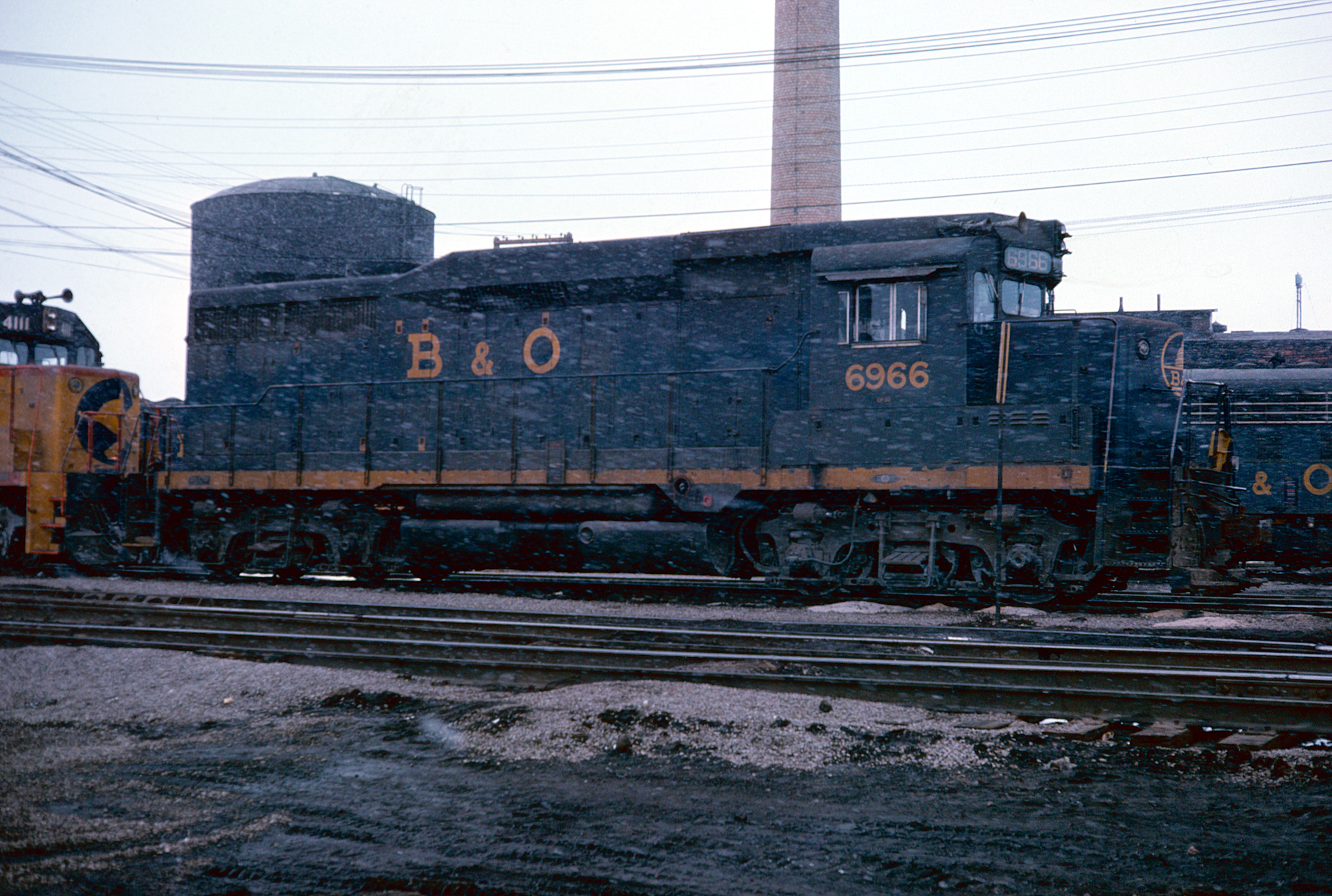EMD "GP30" Locomotives: Data Sheet, Specs, Roster
Last revised: February 20, 2025
By: Adam Burns
The now-classic GP30 was unmistakable. It featured an interesting semi-streamlined design for a road-switcher, sporting a bulbous appendage on the roof, which ran from just above the cab to the dynamic brake blister.
The unique carbody was never repeated by EMD although its flush nose and uniform cab, featuring a two-piece windshield, became a standard design for the next thirty years.
The locomotive was essentially an improved GP20, featuring an upgraded prime mover, greater horsepower, and new advances to keep the engine compartment cleaner.
The GP30 was Electro-Motive's answer to General Electric's recently introduced U25B, the company's entry into the road-switcher market in the spring of 1959.
EMD again found big success with its latest model, selling nearly 1,000 examples to dozens of railroads. While the model was equipped with the low, short hood as a standard option some roads continued to purchase high hood variants and Union Pacific even acquired cabless examples.
Today, the GP30 is well preserved with numerous examples at museums or in operation on tourist lines. Additionally, others remain in service at short lines.
Photos
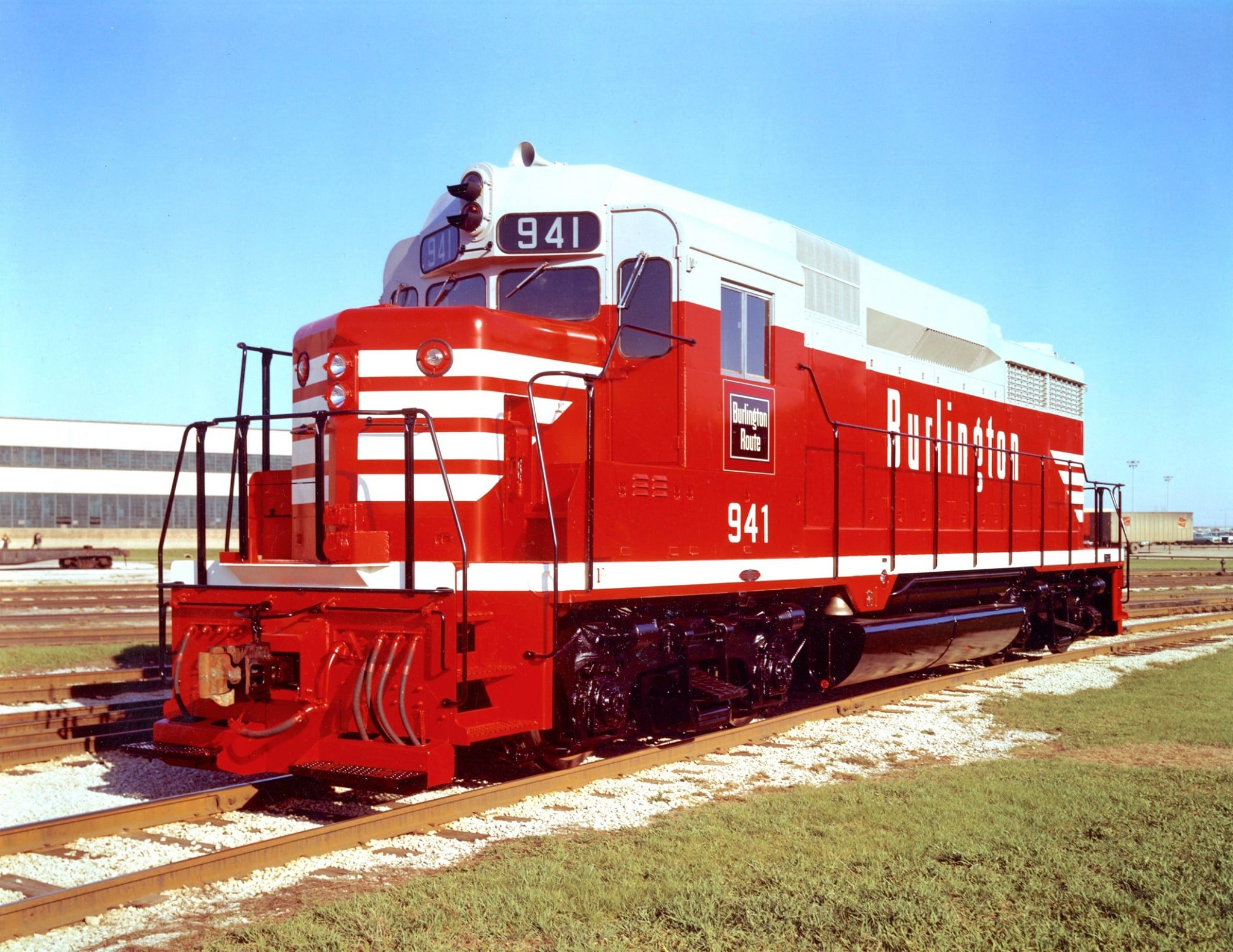 An Electro-Motive photo featuring new Chicago, Burlington & Quincy GP30 #941 in Chinese Red in April, 1962. Warren Calloway collection.
An Electro-Motive photo featuring new Chicago, Burlington & Quincy GP30 #941 in Chinese Red in April, 1962. Warren Calloway collection.Overview
In his book, "EMD Locomotives," author Brian Solomon notes the GP30 was one of the builder's final four-axle road-switchers sporting the 567 prime mover. The model featured the turbocharged 567D3 engine, which could produce 2,250 horsepower.
The GP30 was EMD's first to feature the now-common pointed, low, short hood. This design became EMD's standard until the FRA mandated the wide "safety" cab on every new locomotive in the 1990s.
Interestingly, the GP30 abandoned EMD's brief attempt at attributing horsepower rating to the model name. Apparently, there was no specific reasoning for the use of "30" other than perhaps, as Gerald Foster notes in "A Field Guide To Trains," "GP30" sounded better than "U25B."
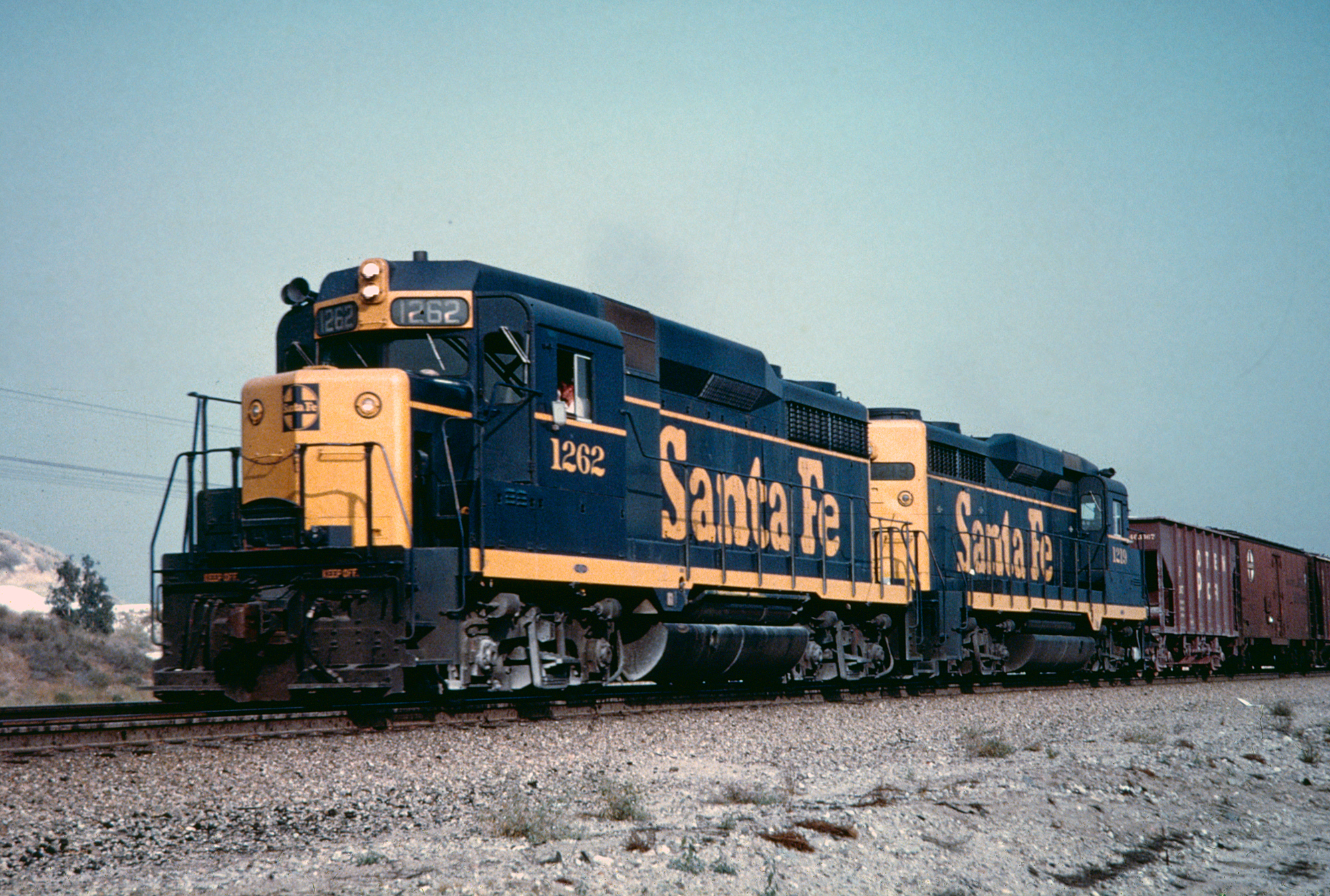 A sharp pair of new Santa Fe GP30's, #1262 and #1219, head west through Los Angeles on May 5, 1963. American-Rails.com collection.
A sharp pair of new Santa Fe GP30's, #1262 and #1219, head west through Los Angeles on May 5, 1963. American-Rails.com collection.Specifications
Much improved over early models like the GP7 and GP9, the GP30 boasted:
- 2,250 horsepower (250 more horsepower than the GP20, which is said to have been achieved through the use of a different turbocharger, since the bore, stroke, compression ratios and RPMs of the two engines were identical).
- Was equipped with dynamic brakes (while not new, the system temporarily employed traction motors as generators and used the resulting electromotive force to slow the train).
- Featured an airtight hood that kept out dust, dirt and other particles from reaching internal components (to cool these critical components the GP30 featured a single air intake for electrical cooling, with a pressurized cooling system).
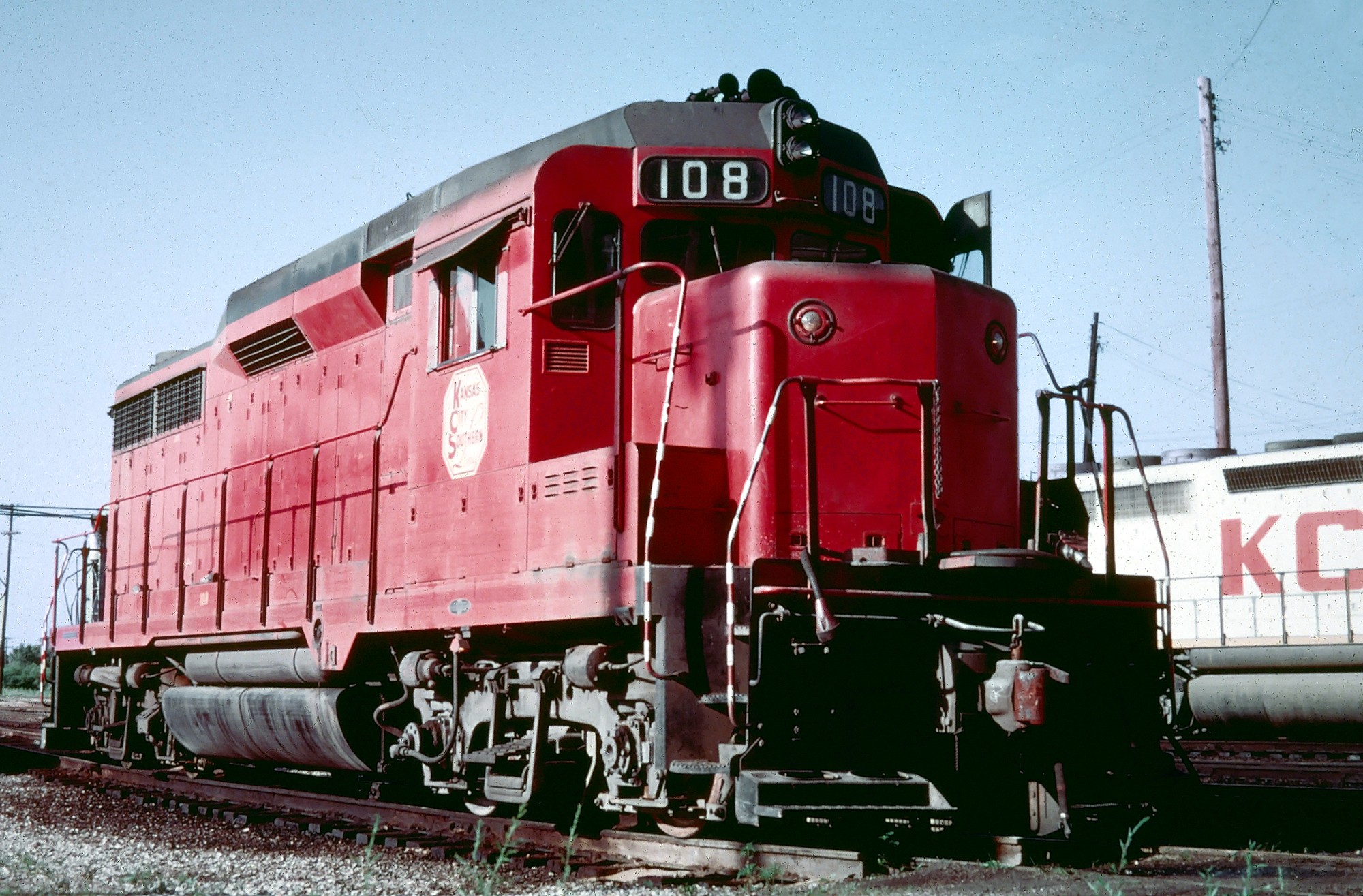 Kansas City Southern GP30 #108 at the road's shops in Pittsburg, Kansas, circa 1969. American-Rails.com collection.
Kansas City Southern GP30 #108 at the road's shops in Pittsburg, Kansas, circa 1969. American-Rails.com collection.Obviously, the model's most recognizable aspect was the carbody featuring a semi-streamlined "bulge" along the roofline between the cab and dynamic brake blister.
In his book, "Diesel Locomotives: Cyclopedia, Volume 2," author Bob Hayden points out the space ahead of the blister actually had a purpose. It housed an electrical cabinet, turbocharger, and central air intake/filter system.
To improve the carbody's appearance, EMD continued this flaring around the blister giving the GP30 a somewhat streamlined appearance. Interestingly, this cosmetic touch was applied to all GP30s, whether they were ordered with dynamics or not.
Spotting Features
While the GP30's roofline bulge was its trademark feature, making it unmistakable from any other EMD design, it also featured some other, less noticeable improvements.
The carbody's walkway was elevated a few inches, which provided space for pipes and electric conduit on the left side and a traction motor cooling air duct on the right.
In addition, Louis Marre notes in his book, "Diesel Locomotives: The First 50 Years," the GP30 was the first to feature all of its radiators at the rear of the long hood; previous variants had included these both ahead, and behind, the exhaust stacks.
Variants
Once again, Canadian lines took no orders on the GP30; the largest orders came from Union Pacific (111), Southern (120), and the Santa Fe (85).
Most buyers stuck with EMD's then-standard low nose. However, some continued to operate high hood road-switchers and ordered theirs with this feature, notably Southern Railway and Norfolk & Western.
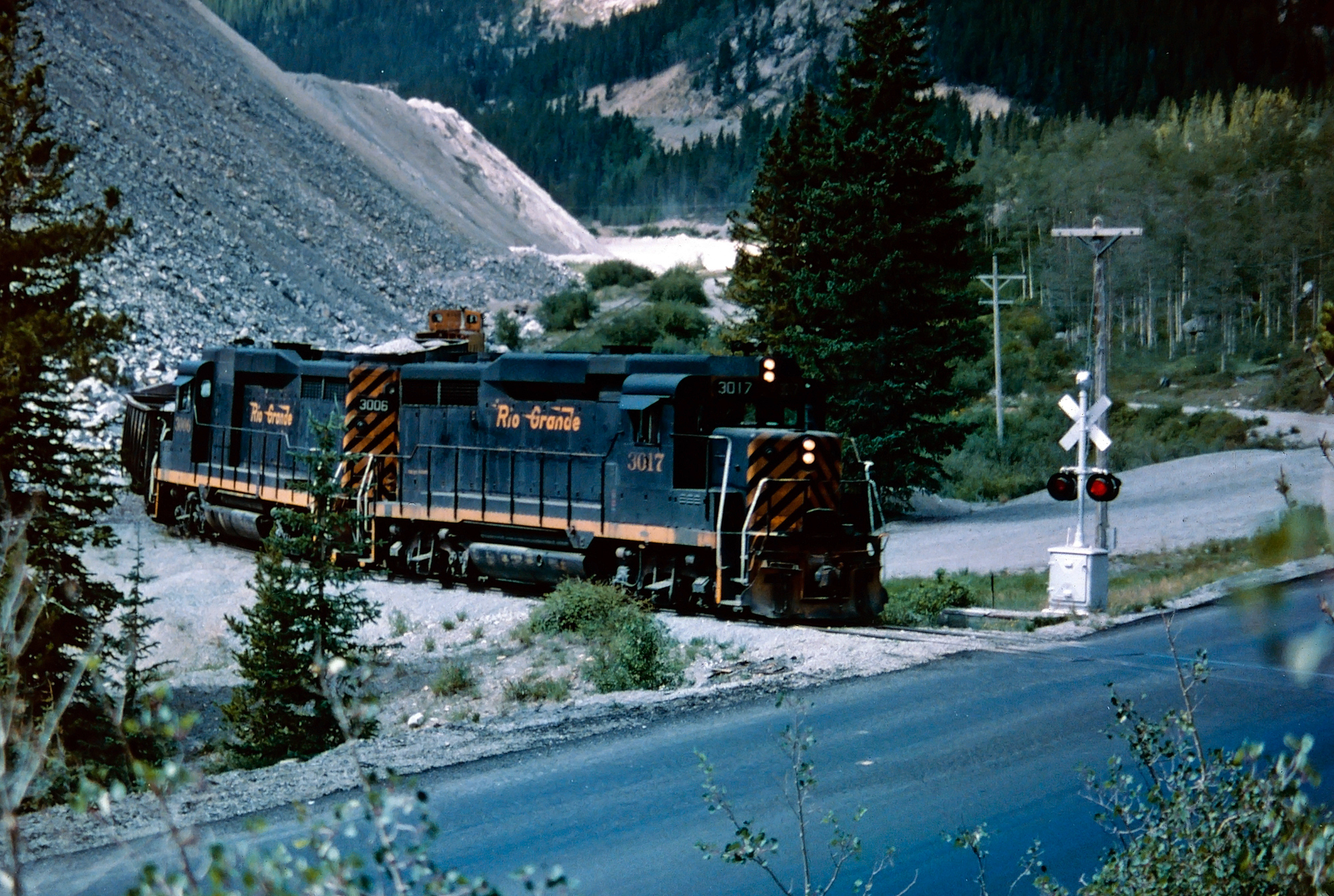 Rio Grande GP30's #3017 and #3006 bring a load of limestone down the stiff grades of the Monarch Branch near Monarch, Colorado on August 24, 1979. Robert Harmen photo. American-Rails.com collection.
Rio Grande GP30's #3017 and #3006 bring a load of limestone down the stiff grades of the Monarch Branch near Monarch, Colorado on August 24, 1979. Robert Harmen photo. American-Rails.com collection.In addition, others like the Milwaukee Road, Soo Line, and Gulf, Mobile & Ohio traded-in older Alcos on new GP30s to reduce costs and utilize GE's rugged 752 traction motors. These variants looked interesting sporting AAR Type B trucks in place of the standard Blombergs.
Union Pacific was the only buyer to acquire cabless variants, forty in all numbered 700B-739B. Interestingly, eight of these (#727B-734B) were ordered with steam generators for passenger service, the only GP30s so equipped.
Data Sheet
| Entered Production | 7/1961 (Demonstrator #5629/#1962) |
| Years Produced | 7/1961 - 11/1963 (7/1963 for GP30B) |
| Engine | 567D3 |
| Engine Builder | GM |
| Horsepower | 2250 |
| RPM | 900 |
| Cylinders | 16 |
| Length | 56' 2" |
| Height (Top Of Rail To Top Of Cab) | 15' 0" |
| Width | 10' 2 ½" |
| Weight | 260,000 Lbs |
| Fuel Capacity | 1700 Gallons |
| Air Compressor | Gardner-Denver |
| Air Compressor Model | WBO |
| Air Brake Manufacturer | Westinghouse |
| Air Brake Schedule | 24L |
| Trucks | B-B |
| Truck Type | Blomberg |
| Truck Wheelbase | 9' |
| Wheel Size | 40" |
| Traction Motors | D57 (4), GM |
| Primary Generator | D22, GM |
| Auxiliary Generator | Delco (64-72) |
| Alternator | D14 |
| MU (Multiple-Unit) | Yes |
| Dynamic Brakes | Yes |
| Gear Ratio | 62:15 |
| Tractive Effort (Starting) | 60,500 Lbs at 25% |
| Tractive Effort (Continuous) | 50,000 Lbs at 9.3 mph |
| Top Speed | 65 mph |
Production Roster
Total Built = 948
| Owner | Road Number(s) | Serial Number(s) | Order Number | Completion Date |
|---|---|---|---|---|
| Electro-Motive (Demonstrator) | 5629 (became Union Pacific #875) | 26613 | 5629 | 7/1961 |
| Reading | 5513-5514, 5520, 5503, 5507, 5505, 5508, 5506, 5501-5502, 5509-5510, 5519, 5504, 5515-5516, 5511-5512, 5517-5518 | 27114-27133 | 7617 | 3/1962-7/1962 |
| Denver & Rio Grande Western | 3001-3010 | 27135-27144 | 7619 | 4/1962-5/1962 |
| Chicago, Burlington & Quincy | 940-969 | 27151-27180 | 7621 | 4/1962-6/1962 |
| Santa Fe | 1200-1234 | 27187-27221 | 7622 | 4/1962-6/1962 |
| Denver & Rio Grande Western | 3011-3013 | 27222-27224 | 7619 | 5/1962 |
| Southern | 2525-2556 | 27313-27344 | 5636 | 8/1962-9/1962 |
| Norfolk & Western | 522-558 | 27355-27391 | 5637 | 6/1962-8/1962 |
| Norfolk & Western | 560-565 | 27393-27398 | 5637 | 8/1962-9/1962 |
| Louisville & Nashville | 1000-1028 | 27399-27427 | 7626 | 7/1962-12/1962 |
| Southern | 2557-2584 | 27428-27455 | 5636 | 9/1961-11/1962 |
| Electro-Motive (Demonstrator) | 5639 (became Seaboard Air Line #534) | 27462 | 5639 | 3/1962 |
| Phelps Dodge Corporation | 24 (New Cornelia Branch Mine) | 27466 | 5641 | 9/1962 |
| Union Pacific | 800-874 | 27509-27583 | 5643 | 7/1962-10/1962 |
| Chesapeake & Ohio | 3002-3015 | 27584-27597 | 7627 | 12/1962-1/1963 |
| Baltimore & Ohio | 6900-6927 | 27617-27644 | 7628 | 10/1962-11/1962 |
| Baltimore & Ohio | 6928-6976 | 27645-27693 | 7631 | 11/1962-1/1963 |
| Phelps Dodge Corp | 25-32 (New Cornelia Branch Mine) | 27728-27735 | 5654 | 6/1963 |
| Milwaukee Road | 340-355 | 27736-27751 | 7656 | 5/1963, 7/1963 |
| Louisville & Nashville | 1029-1048 | 27752-27771 | 7657 | 5/1963-9/1963 |
| Kansas City Southern | 100-109 | 27788-27797 | 5635 | 5/1962 |
| Chesapeake & Ohio | 3000-3001 | 27798-27799 | 7632 | 8/1962, 10/1962 |
| New York, Chicago & St Louis (Nickel Plate Road) | 900-909 | 27894-27903 | 5647 | 11/1962 |
| Gulf, Mobile & Ohio | 500-516 | 27904-27920 | 7635 | 12/1962-4/1963 |
| Gulf, Mobile & Ohio | 517-519 | 27925-27927 | 7635 | 5/1963 |
| Seaboard Air Line | 500-509 | 27928-27937 | 5648 | 11/1962 |
| Seaboard Air Line | 510-533 | 27938-27961 | 7636 | 12/1962-1/1963 |
| Norfolk & Western | 559 | 27978 | 5637 | 8/1962 |
| New York Central | 6115-6124 | 27979-27988 | 7624 | 8/1962 |
| Atlantic Coast Line | 900-907 | 27989-27996 | 7637 | 1/1963 |
| Atlantic Coast Line | 908 | 27997 | 7647 | 1/1963 |
| Denver & Rio Grande Western | 3014-3028 | 28043-28057 | 7640 | 1/1963-2/1963 |
| Santa Fe | 1235-1284 | 28058-28107 | 7642 | 1/1963-6/1963 |
| Pennsylvania | 2200-2251 | 28108-28159 | 7643 | 2/1963-5/1963 |
| Union Pacific | 700-709 | 28160-28169 | 7648 | 2/1963 |
| Alaska Railroad | 2000 | 28171 | 7645 | 3/1963 |
| St. Louis Southwestern Railway (Cotton Belt) | 750-759 | 28172-28181 | 5650 | 2/1963 |
| Southern Pacific | 7400-7407 | 28182-28189 | 7646 | 3/1963 |
| Union Pacific | 710-734 | 28190-28214 | 7648 | 2/1963-3/1963 |
| Great Northern | 3000-3016 | 28261-28277 | 7650 | 4/1963-5/1963 |
| Chicago, Burlington & Quincy | 970-977 | 28292-28299 | 7652 | 4/1963-9/1963 |
| Chicago & North Western | 810-823 | 28304-28317 | 7653 | 4/1963 |
| Soo Line | 701-721 | 28321-28341 | 7654 | 3/1963-6/1963 |
| Soo Line | 700 | 28342 | 7655 | 3/1963 |
| Chicago & Eastern Illinois | 239-241 | 28345-28347 | 7658 | 6/1963 |
| Union Pacific | 735 | 28351 | 7648 | 6/1963 |
| Kansas City Southern | 110-119 | 28388-28397 | 7661 | 7/1963 |
| Chesapeake & Ohio | 3016-3017 | 28410-28411 | 7663 | 8/1963 |
| Gulf, Mobile & Ohio | 520-530 | 28422-28432 | 7666 | 8/1963-9/1963 |
| Chesapeake & Ohio | 3018-3043 | 28494-28519 | 7663 | 8/1963-10/1963 |
| Chesapeake & Ohio | 3044-3045 | 28520-28521 | 7682 | 10/1963 |
| Chesapeake & Ohio | 3046-3047 | 28522-28523 | 7683 | 10/1963 |
| Chicago Great Western | 201-208 | 28526-28533 | 7679 | 8/1963-9/1963 |
| Toledo, Peoria & Western | 700 | 28534 | 7680 | 9/1963 |
| Southern | 2585-2614, 2635-2639, 2630-2634, 2640-2644, 2615-2629 | 28555-28614 | 7669 | 9/1963-11/1963 |
| Louisville & Nashville | 1049-1057 | 28645-28653 | 7687 | 10/1963-11/1963 |
GP30B
| Owner | Road Number(s) | Serial Number(s) | Order Number | Completion Date |
|---|---|---|---|---|
| Union Pacific | 700B-726B | 28215-28241 | 7651 | 4/1963-6/1963 |
| Union Pacific | 727B-739B | 28242-28254 | 7649 | 6/1963-7/1963 |
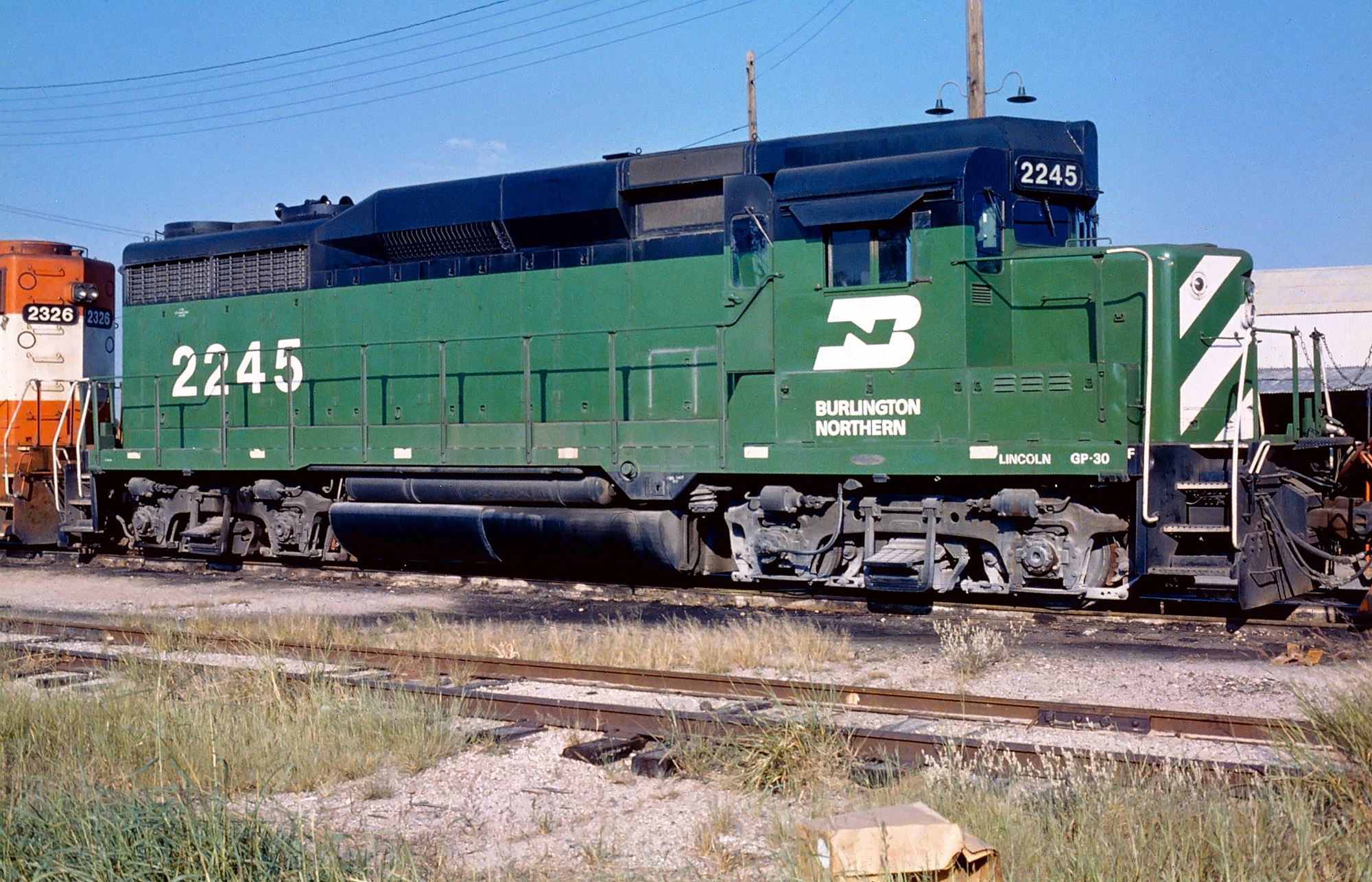 Burlington Northern GP30 #2245, circa 1983. This unit was built as Chicago, Burlington & Quincy #968 in July, 1962. She was later retired in June, 1986. Mike Bledsoe photo. American-Rails.com collection.
Burlington Northern GP30 #2245, circa 1983. This unit was built as Chicago, Burlington & Quincy #968 in July, 1962. She was later retired in June, 1986. Mike Bledsoe photo. American-Rails.com collection.In all, a total of 948 were built during a three-year production run that lasted from 1961-1963. In July, 1963 EMD released the more powerful GP35, a 2,500 horsepower road-switcher which offered the same output as GE's U25B.
This locomotive, which dropped the roofline bulge, was the last four-axle design to sport the 567 prime mover and carried the now-classic second-generation appearance of EMD road-switchers for the next 30 years, including the Spartan Cab.
It was even more successful than its predecessor, selling more than 1,300 examples and easily outpacing similar cataloged models offered from GE and Alco.
Sources
- Pinkepank, Jerry A. Diesel Spotter's Guide. Milwaukee: Kalmbach Publishing Company, 1967.
- Foster, Gerald. A Field Guide To Trains. New York: Houghton Mifflin, 1996.
- Marre, Louis A. Diesel Locomotives: The First 50 Years, A Guide To Diesels Built Before 1972. Milwaukee: Kalmbach Publishing Company, 1995.
- Schafer, Mike. Vintage Diesel Locomotives. Osceola: MBI Publishing, 1998.
- Solomon, Brian. EMD Locomotives. Minneapolis: MBI Publishing Company, 2006.
- Solomon, Brian. GE and EMD Locomotives: The Illustrated History. Minneapolis: Voyageur Press, 2014.
Contents
Recent Articles
-
Rhode Island Murder Mystery Dinner Train Rides
Jun 16, 25 12:24 AM
Let's dive into the enigmatic world of murder mystery dinner train rides in Rhode Island, where each journey promises excitement, laughter, and a challenge for your inner detective. -
Colorado Murder Mystery Dinner Train Rides
Jun 16, 25 12:12 AM
Nestled among the breathtaking vistas and rugged terrains of Colorado lies a unique fusion of theater, gastronomy, and travel—a murder mystery dinner train ride. -
Nevada Murder Mystery Dinner Train Rides
Jun 15, 25 11:56 PM
Seamlessly blending the romance of train travel with the allure of a theatrical whodunit, these excursions promise suspense, delight, and an unforgettable journey through Nevada’s heart.
